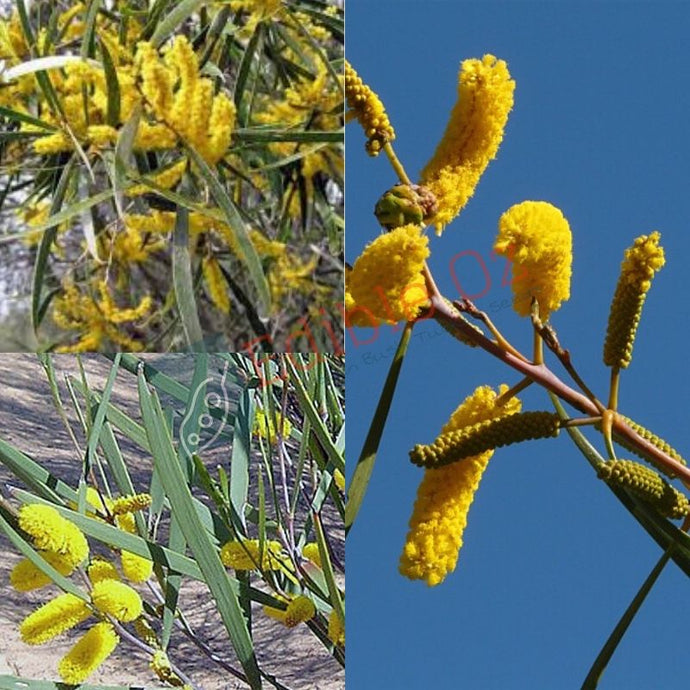
Raspberry Jam Wattle - Acacia acuminata (Mangart) seeds
Regular price
$3.95
Sale
or make 4 interest-free payments of
$0.98 fortnightly with
 More info
More info
Acacia acuminata - Raspberry Jam Tree (Manjart, Munertor, Mungaitch)
A versatile native tree with edible seeds, medicinal uses, and prized wood, valued by the Noongar peoples.
Quick Facts
- Height: Grows as a tall shrub or small tree, typically 3–7 meters.
- Flowers: Lemon-yellow, cylindrical clusters (~2 cm long) appearing late winter to spring.
- Foliage: Narrow phyllodes (modified leaves), providing a soft, graceful appearance.
- Soil: Adapts to a variety of well-drained soils, including saline and sandy soils.
- Position: Thrives in full sun; tolerates frost and medium salinity.
Why Grow Acacia acuminata?
Raspberry Jam Tree is a resilient and multifunctional plant perfect for bush food gardens, reforestation projects, and ornamental landscapes. Its sweetly scented wood, edible seeds, and cultural significance make it a rewarding and valuable addition to any space.
Bush Food Note
The seeds, gum, and resin of Acacia acuminata are all edible:
-
Seeds:
- High in protein (45%), fats (28%), and carbohydrates (15%).
- Traditionally ground into flour for cakes or other foods.
-
Gum (Resin):
- Edible and can be used to make tea or consumed as a snack.
- Preparation: Seeds are roasted or ground; gum can be steeped in hot water for a flavorful drink.
Bush Medicine
The resin and sap of Acacia acuminata have traditional medicinal uses:
- Sap: Collected and administered as medicine, either fresh or prepared for later use.
Disclaimer: Information about traditional bush medicine is provided for educational purposes only. Always consult a healthcare professional before use.
Other Uses
-
Wood:
- Highly valued for its durability and pleasant raspberry jam scent when freshly cut.
- Traditionally used by Noongar peoples to craft kylies (boomerang-type weapons).
- Erosion Control: Deep root systems stabilise soil in degraded areas.
- Reforestation: Ideal for native revegetation projects due to its resilience and ecological benefits.
How to Grow
-
Sowing Instructions:
- Scarify seeds or soak in boiling water for 12–24 hours to improve germination rates.
- Sow in well-drained soil and cover lightly.
-
Position:
- Choose a sunny location for optimal growth.
- Suitable for areas with frost or medium soil salinity.
-
Care Tips:
- Water regularly during establishment; drought-tolerant once mature.
- Prune lightly to shape or control growth as needed.
- Mulch around the base to retain soil moisture and suppress weeds.
Uses in Your Garden
- Bush Food Garden: Produces edible seeds and resin for traditional and modern culinary uses.
- Reforestation Projects: Stabilises soil and supports ecological restoration.
- Ornamental Value: Lemon-yellow flowers and fragrant wood enhance landscapes.
- Wildlife Habitat: Provides food and shelter for insects, birds, and small mammals.
Germination Tips
- Timeframe: Germination typically occurs within 2–4 weeks.
- Pre-Treatment: Scarify seeds or soak in boiling water to soften the seed coat.
- Moisture: Keep soil moist but avoid waterlogging during germination.
- Light: Ensure seeds are placed in a sunny or well-lit area.
Order Now
Bring the resilience and utility of Acacia acuminata to your garden or restoration project. With its edible seeds, medicinal properties, and durable wood, Raspberry Jam Tree is a versatile and rewarding native plant.
Order your Raspberry Jam Tree seeds today and grow a piece of Australia’s natural and cultural heritage!
